Editor’s note: We asked local historian Dave Allston to come up with a top ten list of “don’t miss” sites to check out during Doors Open Ottawa on June 6 and 7. Make sure you read to the end to find out which sites he’d like to see on the list for 2016!
The 2015 edition of Doors Open includes 129 sites throughout the City of Ottawa and the surrounding region. Get the full list online at ottawa.ca.
Since its inception in 2002, Doors Open Ottawa has become a much anticipated part of Ottawa’s summer event schedule.
It’s an event that gives residents an opportunity to view some of the city’s most interesting but perhaps rarely-seen building interiors. In its first year, 50,000 people visited 88 sites. By 2014, the attendance mark had risen over the 70,000 mark, and it promises to increase as the popularity of the event continues to swell.
The emphasis of the festival is on buildings which represent Ottawa’s built heritage, those rich with history, culture and architecture. Kitchissippi is full of buildings like this, and on June 6 and 7, residents will have the opportunity to explore some hidden gems in the neighbourhood. (Do note, that some sites are open only one of the two days!)
With local history and heritage in mind, here’s our list of the best Kitchissippi sites to visit during Doors Open this year.
10.Ottawa Integrative Cancer Centre
(29 Bayswater Ave.)
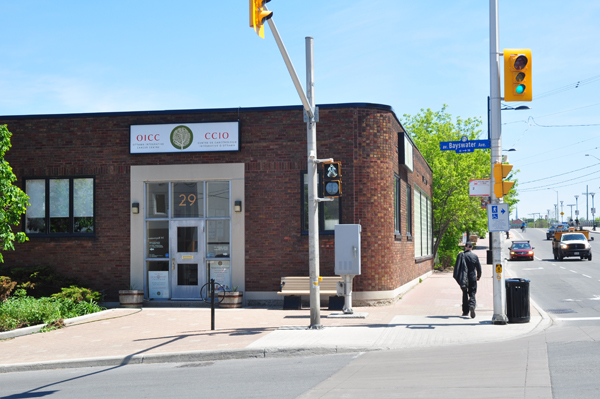
This building is currently the location of some revolutionary work on cancer research, education and care – the first facility of its kind in Eastern Canada. It also played an important role in the development of television media in Ottawa. It was the launch site of Ottawa’s first private television station, CJOH, which began broadcasting here in the relatively small, rented office space on March 12, 1961. (Some residents may remember the 72-foot microwave television tower on its roof.) Within a year, CJOH completed construction on a new location on Merivale Road, and moved from the cramped quarters of Bayswater Avenue. The OICC building dates back to the 1940s, when it was used as an office on the D. Kemp Edwards lumber property. Following CJOH’s departure it became King Discount, Playford Electric, and had various other office uses over the years. Visitors to the OICC will be able to see where Ottawa television was born as well as the cutting-edge cancer research that is happening right here in Kitchissippi.
9. Enriched Bread Artists & Gladstone Clayworks
(949-951 Gladstone Ave.)
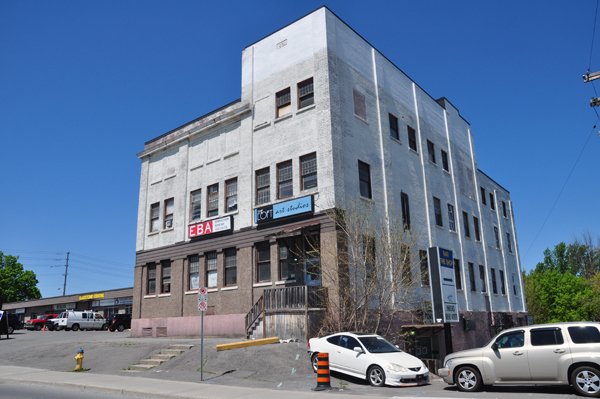
This address is home of two separate businesses, but both share one of Kitchissippi’s most unique and interesting vintage buildings, the Standard Bread Company building. Built in 1924 by Cecil Morrison on isolated Oliver Street (now Gladstone) for its proximity to both the city and the growing west-end suburbs, Standard Bread was a tremendous success during an era when wheat was booming and the economy was strong. What is amazing about this building is how it has retained many elements of the original light industrial operations. There is an endless maze of rooms and staircases which make the building a piece of art itself. Check out the second floor where the ovens were located, and bread baking took place. The dough was mixed on the third floor, and business operations were kept on the first floor. But the building is only a small part of the reason to visit. Within its walls is a collective of local artists who will be displaying and discussing their projects. Though EBA has been resident since 1992, and Clayworks since 2003, it is still easy to catch a whiff of Ottawa’s biggest loaf of bread (the “Mother Loaf” as it was called) and have the special museum-like experience of being inside an early 20th century industrial plant.
8. Stables Artists Studios
(155 Loretta Ave. N.)
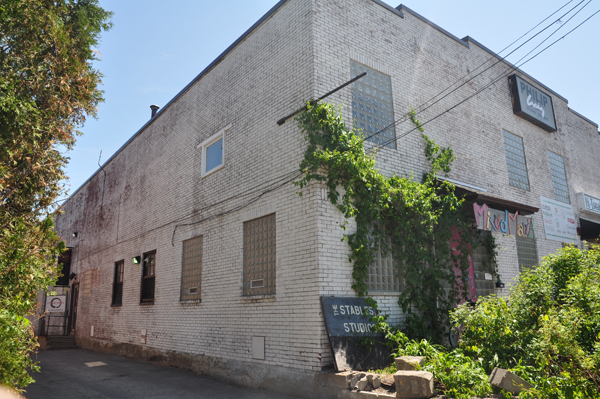
This building was part of the Standard Bread property, and it had a marvellous original purpose: to house the company’s horses. The lower level, which now features artists studios and an art restoration service, was the stable area, and the hayloft was upstairs. (It is now the Aikikai Akido martial arts studio.) In 1929, Standard Bread had 55 horse-drawn wagons delivering their product to Ottawa homes. Residents in the burgeoning area complained about the early morning sounds of hundreds of horse hooves clopping down Gladstone Avenue. The company remedied the issue with innovative rubber tires on their wagons and rubber shoes on all horses. By the 1940s, wagons were a thing of the past. The stable building has survived through various uses (taxi dispatch, electronics distribution) and we are fortunate to still be able to see such a neat piece of local history firsthand.
7. Ottawa Main Mosque
(251 Northwestern Ave.)

This is Ottawa’s first mosque, and the result of many years of effort by Ottawa’s growing Muslim population in the 1960s and 1970s. The Ottawa Muslim Association formed in 1962, and one of their first objectives was the creation of a place of worship. The Association had simple goals: to hold weekly prayers, teach religion to the growing Muslim population of Ottawa, and to foster better understanding between Muslims and other Canadians. The Association rented basement space from Northwestern Church for several years, before purchasing their half-acre lot. They used the existing house on the lot as a worship centre, and endeavoured to raise enough funds to build the mosque. Contributions were received from many world-wide and local sources, and construction began in 1973, continuing as the group raised the funds. The first events were held in late 1976, but the mosque was finally completed in February of 1979 when the 20 ton enclosed platform was raised and placed on top of the minaret (the first in North America to be built of precast concrete segments). This is a wonderful opportunity to visit a true landmark, and, as a bonus in past years, the mosque has made available various food samples during Open Doors, which is a highlight in and of itself.
6. Festival House
(450 Churchill Ave. N.)
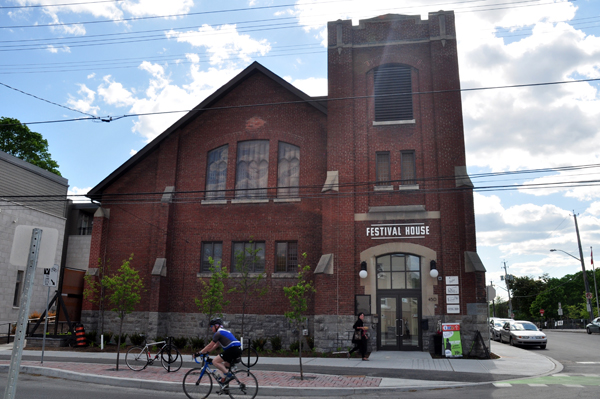
Built in 1913, the Westboro United Church originally housed both the Westboro Methodist and Presbyterian Churches, which had existed since the 1860s. Bluesfest bought the church for $1 with a promise to re-purpose it as community space, featuring art and music classes. $2M in renovations later, the former church re-opened in May of 2014, and is now the headquarters of several music festival organizations. Westboro is fortunate that the church exterior was saved so that it may live on as a landmark structure in the community. It’s an ideal representation of how a heritage building can be preserved and put to new use successfully, without demolition. The preserved beams, stained glass windows, brick walls, and other architectural features are worth checking out, along with the exciting, modern office and class spaces that have been created.
5. Saint-François-d’Assise Church
(20 Fairmont Ave.)

2015 is a year of significant milestones for the Saint-François-d’Assise Church. It’s celebrating its 125th birthday this year as a parish. It is also 100 years since construction on the current church was completed. The church is perhaps the best known landmark in Hintonburg, and has been so integral to its history. Innumerable weddings, baptisms and funerals of local residents have been held here. Inside are many features that date back to its original construction and beyond – from the historic organ, to the original pews, to the many 19th century statutes relocated from other local parishes, not to mention the church’s five bells that were cast in France in 1924. The church has a dedicated group of volunteers and historians who give tours at various times during the year.
4. Ottawa Jewish Archives
(21 Nadolny Sachs Private)
Although this site is just outside Kitchissippi borders, it deserves a spot on our “must visit” list. The OJA is an important and impressive archival institution within the Soloway Jewish Community Centre. Visiting during Open Doors is not only a chance to see an archival institution at work (how photographs and artefacts are accumulated, preserved and displayed), but to learn more about prominent Jewish residents, groups and businesses. One story in particular is that of Moses Bilsky, believed to be Ottawa’s first Jewish resident, and a man who lived an incredible life.
Particularly worth seeing is the audio-visual station, where sound recordings and films in the archive’s collection can be seen. These will include digitized home movies filmed in downtown and lowertown Ottawa in the 50s and 60s, a documentary on the family-owned Rideau Bakery, and the oral testimony of an Ottawa Holocaust survivor.
3. Holy Rosary Church
(20 Grant St.)
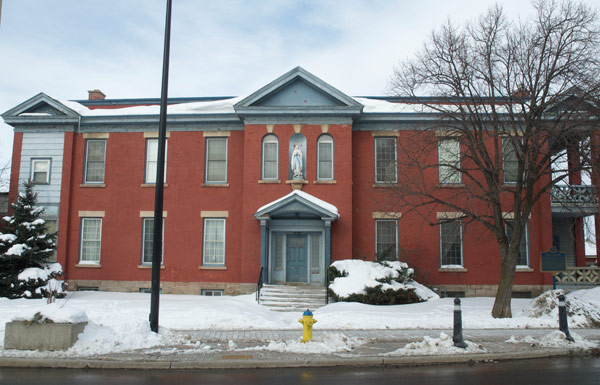
This historic building has a surprising past. It had its beginnings as a wood-framed home in the 1870s and was acquired in 1895 to become the New Orpington Lodge (later known as St. George’s Home), a “distribution centre” for Home Children, which was the term given to British children (sometimes orphans, mostly not) who were sent to Canada to work as cheap labour on farms and as domestic help between 1896 and 1935. Thousands of children passed through these doors. The brick portion fronting Wellington was added in 1912, and the chapel at the rear just after WWI. There is so much history in one building. You can read a bit more about it in this archived Q&A.
2. Westboro Masonic Hall
(430 Churchill Ave. N.)
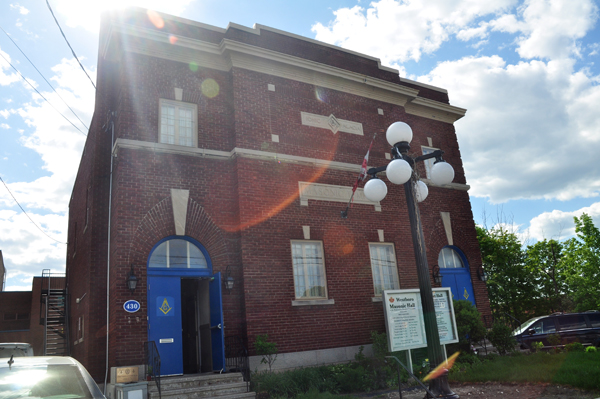
I am frequently asked about this building, and what’s inside it. The Masonic Temple (Hall) was designed by famous Ottawa architects Abra and Richards, who also designed Nepean High School. It was built in 1924 to serve the members of the Ionic and Acacia Lodges of Westboro, whose names are engraved in stone at the front of the building. The Masonic Order are a fraternal organization first established to regulate the qualifications of stonemasons and their interaction with authorities and clients. The Hall was paid for and owned by members of the local Masonic Order, and until recently was used almost exclusively by members. In recent years, the Hall has been rented to other organizations for meetings, banquets and weddings. The impressive ceilings, mouldings and vintage photographs make this is a worthwhile visit into what truly was a hidden Westboro curiosity for many years.
1. Thomson Hall (Keg Manor)/Maplelawn Gardens
(529 Richmond Rd.)

This is where Westboro began. If you have never been through the original Thomson family house, or strolled the walled gardens (one of the final remaining examples of early-19th century Canada), then I insist you take this opportunity during Open Doors. The Thomson family were Westboro’s pioneers. They arrived around 1819 and built Maplelawn by 1831. The home passed through the Cole and Rochester families over the following 150 years, before being acquired by the NCC in 1989. Though extensively renovated, there are numerous original features. The gardens are impressive, and are one of Ottawa’s most underrated wedding-photo venues (my wife and I had ours here in 2009). It is a National Historic Site, and a must to visit. You may even see one of its reputed ghosts.
Finally, for 2016, there are so many buildings in Kitchissippi that I would love to see participate in Open Doors Ottawa. My personal wishlist includes:
- The 1830s-built Aylen-Heney stone house on Richmond Road near Kirkwood
- The Capital Wire Cloth Building between Hamilton and Hinton (and the DNA11 offices which currently occupy part of the main floor are tour-worthy on their own)
- The stone-faced Peruvian embassy on Island Park Drive at Helena
- The 1854 stone mansion Richmond Lodge on Armstrong
- The 1880 stone Magee House at 1119 Wellington (I loved exploring this building when it was an antique shop in the mid-90s)
- The historic (and sadly threatened) Reid Farm house located in Reid Park near Sherwood Drive